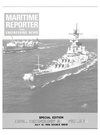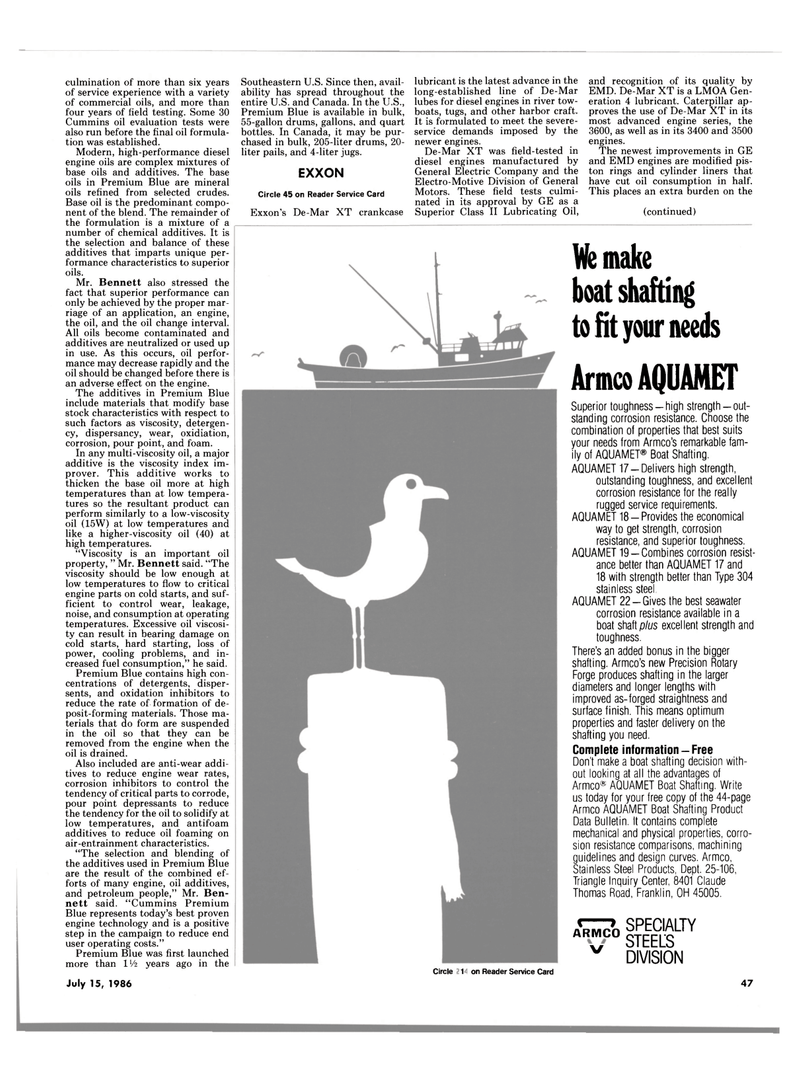
Page 47: of Maritime Reporter Magazine (July 15, 1986)
Read this page in Pdf, Flash or Html5 edition of July 15, 1986 Maritime Reporter Magazine
culmination of more than six years of service experience with a variety of commercial oils, and more than four years of field testing. Some 30
Cummins oil evaluation tests were also run before the final oil formula- tion was established.
Modern, high-performance diesel engine oils are complex mixtures of base oils and additives. The base oils in Premium Blue are mineral oils refined from selected crudes.
Base oil is the predominant compo- nent of the blend. The remainder of the formulation is a mixture of a number of chemical additives. It is the selection and balance of these additives that imparts unique per- formance characteristics to superior oils.
Mr. Bennett also stressed the fact that superior performance can only be achieved by the proper mar- riage of an application, an engine, the oil, and the oil change interval.
All oils become contaminated and additives are neutralized or used up in use. As this occurs, oil perfor- mance may decrease rapidly and the oil should be changed before there is an adverse effect on the engine.
The additives in Premium Blue include materials that modify base stock characteristics with respect to such factors as viscosity, detergen- cy, dispersancy, wear, oxidiation, corrosion, pour point, and foam.
In any multi-viscosity oil, a major additive is the viscosity index im- prover. This additive works to thicken the base oil more at high temperatures than at low tempera- tures so the resultant product can perform similarly to a low-viscosity oil (15W) at low temperatures and like a higher-viscosity oil (40) at high temperatures. "Viscosity is an important oil property, " Mr. Bennett said. "The viscosity should be low enough at low temperatures to flow to critical engine parts on cold starts, and suf- ficient to control wear, leakage, noise, and consumption at operating temperatures. Excessive oil viscosi- ty can result in bearing damage on cold starts, hard starting, loss of power, cooling problems, and in- creased fuel consumption," he said.
Premium Blue contains high con- centrations of detergents, disper- sents, and oxidation inhibitors to reduce the rate of formation of de- posit-forming materials. Those ma- terials that do form are suspended in the oil so that they can be removed from the engine when the oil is drained.
Also included are anti-wear addi- tives to reduce engine wear rates, corrosion inhibitors to control the tendency of critical parts to corrode, pour point depressants to reduce the tendency for the oil to solidify at low temperatures, and antifoam additives to reduce oil foaming on air-entrainment characteristics. "The selection and blending of the additives used in Premium Blue are the result of the combined ef- forts of many engine, oil additives, and petroleum people," Mr. Ben- nett said. "Cummins Premium
Blue represents today's best proven engine technology and is a positive step in the campaign to reduce end user operating costs."
Premium Blue was first launched more than 1 'A years ago in the
July 15, 1986
Southeastern U.S. Since then, avail- ability has spread throughout the entire U.S. and Canada. In the U.S.,
Premium Blue is available in bulk, 55-gallon drums, gallons, and quart bottles. In Canada, it may be pur- chased in bulk, 205-liter drums, 20- liter pails, and 4-liter jugs.
EXXON
Circle 45 on Reader Service Card
Exxon's De-Mar XT crankcase lubricant is the latest advance in the long-established line of De-Mar lubes for diesel engines in river tow- boats, tugs, and other harbor craft.
It is formulated to meet the severe- service demands imposed by the newer engines.
De-Mar XT was field-tested in diesel engines manufactured by
General Electric Company and the
Electro-Motive Division of General
Motors. These field tests culmi- nated in its approval by GE as a
Superior Class II Lubricating Oil, and recognition of its quality by
EMD. De-Mar XT is a LMOA Gen- eration 4 lubricant. Caterpillar ap- proves the use of De-Mar XT in its most advanced engine series, the 3600, as well as in its 3400 and 3500 engines.
The newest improvements in GE and EMD engines are modified pis- ton rings and cylinder liners that have cut oil consumption in half.
This places an extra burden on the (continued)
Circle 135 on Reader Service Card
We make boat shafting to fit your needs
Armco AQUAMET
Superior toughness-high strength - out- standing corrosion resistance. Choose the combination of properties that best suits your needs from Armco's remarkable fam- ily of AQUAMET® Boat Shafting.
AQUAMET 17-Delivers high strength, outstanding toughness, and excellent corrosion resistance for the really rugged service requirements.
AQUAMET 18-Provides the economical way to get strength, corrosion resistance, and superior toughness.
AQUAMET 19-Combines corrosion resist- ance better than AQUAMET 17 and 18 with strength better than Type 304 stainless steel
AQUAMET 22-Gives the best seawater corrosion resistance available in a boat shaft plus excellent strength and toughness.
There's an added bonus in the bigger shafting. Armco's new Precision Rotary
Forge produces shafting in the larger diameters and longer lengths with improved as-forged straightness and surface finish. This means optimum properties and faster delivery on the shafting you need.
Complete information-Free
Don't make a boat shafting decision with- out looking at all the advantages of
Armco® AQUAMET Boat Shafting. Write us today for your free copy of the 44-page
Armco AQUAMET Boat Shafting Product
Data Bulletin. It contains complete mechanical and physical properties, corro- sion resistance comparisons, machining guidelines and design curves. Armco,
Stainless Steel Products, Dept. 25-106,
Triangle Inquiry Center, 8401 Claude
Thomas Road, Franklin, OH 45005.
S?0 SPECIALTY ARMCO STEELS v DIVISION 47

 46
46

 48
48
